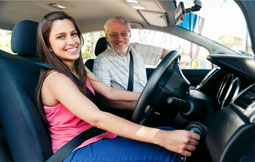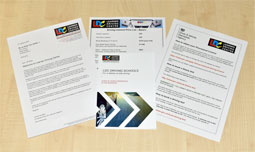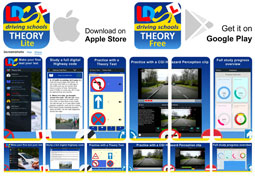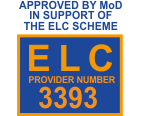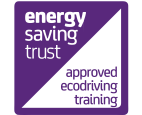Driving lesson 3. Steering
Introduction
While it is relatively easy to make slight steering adjustments many manoeuvres require you to turn the car sharply to either the left or to the right. To do this effectively you need to learn the 'pull-push' method of steering.
It is also important when driving an unfamiliar car for the first time that you locate all the ancillary controls before starting your journey.
Key learning points
 Steering
Steering
What is probably the most important rule about steering may not seem obvious. When driving you not only steer with your hands, but also with your eyes. You do this by looking where you want the car to go, this in turn will tell your brain what to do with your hands and steer accordingly. Your peripheral vision (i.e. your vision to the sides) helps you to keep your road position.
 Pull-push method
Pull-push method
This method ensures that you keep both hands in contact with the wheel at all times and that the wheel is never allowed to spin out of control. Once the wheels are fully turned left or right this is known as full lock.
 The procedure for turning full lock to the right:
The procedure for turning full lock to the right:
- Pull the steering wheel down with your right hand whilst sliding your left hand down.
- Push the steering wheel up with your left hand whilst sliding your right hand up.
- Pull the steering wheel down with your right hand whilst sliding your left hand down.
- Repeat the previous steps until full lock is achieved or you have steered sufficiently for your intended manoeuvre.
The procedure for turning full lock to the left:
- Pull the steering wheel down with your left hand whilst sliding your right hand down.
- Push the steering wheel up with your right hand whilst sliding your left hand up.
- Pull the steering wheel down with your left hand whilst sliding your right hand down.
- Repeat the previous steps until full lock is achieved or you have steered sufficiently for your intended manoeuvre.
Ancillary controls
 Horn
Horn
The horn is usually located either in the middle of the steering wheel or on the end of a stalk. Rules for the use of the horn can be found in the Highway Code.
Lights
The light switches are usually on a stalk or a separate switch on the dashboard. There are three settings for the lights.
 Sidelights - these can be used when leaving your car parked at night.
Sidelights - these can be used when leaving your car parked at night.
Dipped headlights - these should be used whenever visibility is reduced and during the hours of darkness.
Full beam headlights -
these should be used during the hours of darkness on an unlit road with no oncoming or proceeding traffic. Do not use them in foggy conditions, as they will reduce visibility further. When the main beam lights are on you will see a blue warning light on the dashboard.
Whichever lights you switch on, the tail-lights and the number plate light will also come on.
Fog lights
 These should only be used when visibility is reduced to less than 100 metres.
These should only be used when visibility is reduced to less than 100 metres.
The fog lights will not usually work unless the dipped headlights are switched on.
When the rear fog lights are switched on you will usually see an orange warning light on the dashboard and a green light when the front fog lights are on.
Hazard warning lights
 The switch for the hazard warning lights is usually red or has a large red triangle on it. Hazard warning lights should be used when your vehicle is causing a hazard to other road users due to a breakdown. They must not be used as justification for illegal parking, or when your car is moving, unless it is to warn other drivers of a hazard ahead on a motorway or unrestricted dual carriageway. When operated, all the indicators on the car flash at the same time.
The switch for the hazard warning lights is usually red or has a large red triangle on it. Hazard warning lights should be used when your vehicle is causing a hazard to other road users due to a breakdown. They must not be used as justification for illegal parking, or when your car is moving, unless it is to warn other drivers of a hazard ahead on a motorway or unrestricted dual carriageway. When operated, all the indicators on the car flash at the same time.

Windscreen wipers and washers
![]() On the opposite stalk to the indicators you should find the windscreen wipers and washers control. Operate this stalk with your fingertips, just like you do the indicator stalk.
On the opposite stalk to the indicators you should find the windscreen wipers and washers control. Operate this stalk with your fingertips, just like you do the indicator stalk.
Depending on the make and model of your car move the stalk either upward or downward to operate the wipers.
- One click will bring on the intermittent wipe;
- Two clicks will operate the normal speed wipers;
- The third click will operate the double speed wipers.
To wash the windscreen move the stalk either towards you or away from you, depending on the make and model of car. There will also be a control for the rear wiper and washer, if there is one fitted.
 Demisters and heaters
Demisters and heaters
All cars are fitted with demisters, these will help to keep your windows clear at all times. Make sure the heat and fan are turned up and the air is directed onto the windscreen. Most cars have a heated rear windscreen, some cars also have a heated front windscreen.
The dashboard
On the dashboard there are several warning lights and gauges. If any of the lights light up when you are driving, stop and check the user's manual to find out what the problem is and whether or not you should drive the car further.
 The speedometer will be displayed on the dashboard, this tells you what speed you are travelling at.
The speedometer will be displayed on the dashboard, this tells you what speed you are travelling at.
There might also be a rev counter, this tells you what speed the engine is rotating.
Each turn of the engine is known as a revolution, hence the term rev counter.
The fuel gauge and temperature gauge will also be displayed on the dashboard. The temperature gauge tells you the temperature of the engine, if it shows high or red you must not drive the car any further.
Your instructor will explain the ancillary controls in more detail and how these work in their car.
Highway Code study
Rules: 112 - 116.
Page: 128 (warning displays)

